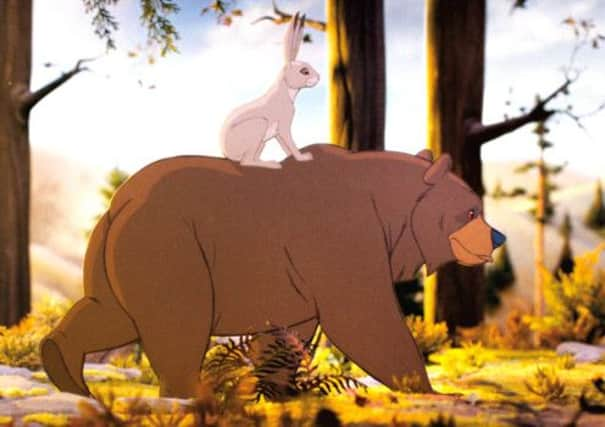Dani Garavelli: Set for a consumer Christmas


Or perhaps you’d make a gingerbread house, decorate its rooftop with icing and Smarties and pop a marzipan snowman outside the front door. Lots of simple traditions could herald the onset of the Christmas season: opening the first door of the Advent calendar, dousing the cake with brandy or even the smell of a freshly-peeled tangerine.
In these days of social media, however, we are forced to mark it earlier and collectively with a mass viewing and dissection of the John Lewis advert. Instead of ooh-ing and aah-ing at the turning on of the city lights, we ooh and aah at the way a two-minute cartoon featuring a couple of rejects from Watership Down can wring tears from our eyes and extort money from our wallets. For the gullible these oohs and aahs may signal an appreciation of the schmaltz-fest; for the rest of us it’s more a case of “How the f*** can it have come to this?”
Advertisement
Hide AdAdvertisement
Hide AdAs you’ll know by now, unless you have been hibernating, this year’s effort involves a bear and a hare and unfolds to the strains of Lily Allen singing Keane’s Somewhere Only We Know. Despite their mismatched shapes, bear and hare are best mates, but bear always misses Christmas due to his annoying ursine habit of sleeping through winter. Then hare has an idea. He buys bear – get this – an alarm clock from John Lewis, which wakes bear up in time to share in the celebrations. Cue a loving look from hare, sodden hankies and jingle tills all the way to 24 December.
This modern-day ritual, as significant for some as a trip to see Santa, has developed its own rhythms and phases. In the run-up to the big reveal, there is the breathless speculation. Will the storyline be exciting? How much money will John Lewis have thrown at the campaign? (£7m) Which singer will be using the ad, which is receiving its TV premiere during The X-Factor, to relaunch their flagging career? Then, after it has been shown, there is the reassuring forming of a Twitter consensus. Yes, it was better than last year’s which featured Mr Snowman trekking half way across the country to buy Mrs Snowman matching hat and gloves, but no, it didn’t come close to the one the year before with the wee boy who couldn’t wait for Christmas to come so he could give his mum and dad their present (even I cried at that). Finally, there’s the communal piss-take, a tradition started by Charlie Brooker in 2011 when he suggested the lovingly-wrapped box handed over by the aforementioned boy contained the severed head of the family dog. This year, there have been many references to bear catching TB from the badgers and an “alternative ending”, which shows a woman lying across a sofa with a bear-skin rug draped over the back. This year too we’ve been extra lucky because there’s been a whiff of a plagiarism scandal to keep us entertained. Could the plotline have been stolen from a children’s book called Bear Stays Up For Christmas? Who cares, but it keeps us talking.
It’s not just the John Lewis ad that’s seen as a landmark on the long road to the big day. Marks & Spencer has created a Gothic fantasy which shows a woman falling down a pothole into a magical world. It’s a confusing mishmash of every fairytale from Alice in Wonderland to Aladdin in which Rosie Huntington-Whiteley’s clothes fall off for no apparent reason and Helena Bonham Carter plays the wizard from the Wizard of Oz. Even Cadbury is in on the act, with an advert that involves wrapping an entire street in 2,500 metres of purple paper, 60 feet of printed tape and 18-feet bows and stars two eight-year-old boys who earned a year’s supply of chocolate for their efforts.
The supermarkets, criticised last year for presenting a sexist (but largely accurate) image of mothers taking on most of the responsibility for making Christmas special, have changed tack. Eschewing celebrities, Tesco has gone down the nostalgia route. Taking its inspiration from John Lewis’s classic She’s Always A Woman ad, it tracks one family’s Christmases over decades through their home videos.
Every year it seems the ante is raised, the irony being that the poorer we all become the more effort is apparently invested in encouraging us to spend what little we have on shiny baubles. If there is something offensive about these ads, it is not their commercialism per se – their raison d’etre is to sell things after all – but the way that commercialism is dressed up as something loftier. The story of bear and hare is not really a sales pitch at all, you understand, but a miniature morality tale, as profound in its own way as Dickens’ A Christmas Carol. It reminds us to make the effort to show those around us just how much we care (albeit by means of a gift purchased from the company’s very own emporium).
Now the starting gun has been fired and the shopping days countdown has begun, I am itching to draw up my own to-buy list. That’s precisely the way John Lewis wants me to feel. But wait. Perhaps the lesson to be drawn from its festive fable is not that we should search high and low for the perfect gift as a symbol of our love, but that, thanks to the company’s efforts, we might as well not bother. After all the fanfare and razzmatazz around the Christmas advert launches, how could the day itself be anything other than an anti-climax?
Twitter: @DaniGaravelli1